A Topical Map is a key component of Semantic SEO, which is all about understanding the intent behind user queries and delivering highly relevant results.
When it comes to implementing your SEO Content Strategy, it allows search engines to more accurately determine what a website is talking about.
This article will guide you through how you can create a Topical Map for SEO, implement it, and use it to improve your website’s search engine rankings.
Table of Contents
- 1 What is a Topical Map for SEO?
- 2 How to Create a Topical Map
- 2.1 Understanding Topic and Sub-Topic Hierarchy
- 2.2 1. Niche SEED Keyword
- 2.3 2. Keyword Research
- 2.4 Building on Your Keyword Research Results
- 2.5 3. Keyword Clustering
- 2.6 4. Topic Visualization When Creating a Topical Map
- 2.7 5. Planning a Topic Cluster Content Strategy:
- 2.8 6. Competitor Analysis
- 2.9 7. Content Depth and Format Consideration:
- 2.10 8. Enhance Content Relevance With LSI Phrases
- 2.11 9. Translating Your Topical Map Into Site Architecture
- 3 FINAL THOUGHTS
What is a Topical Map for SEO?
Creating a Topical Map for SEO involves planning a content or information layout that organizes and displays a set of topics in their order of semantic relevance.
However, this isn’t just about planning content; it’s about orchestrating it into a well-structured topic and subtopic hierarchy.
So, why should you care?
We all want more Google traffic – I mean, who doesn’t, right?
That’s where building topical authority comes in.
It’s a brilliant SEO strategy that makes Google see your site as the ultimate guru on a particular subject.
But here’s the catch: To become a trusted source, your website must be a comprehensive resource on your chosen topic, all neatly organized in a parent-child hierarchy.
Why the hierarchy?
It’s not just about helping users navigate; it’s also about making search engines understand your site’s architecture.
Semantic search, you see, thrives on this understanding, and the better Google gets it, the higher your site soars in the rankings.
So, you might be wondering, “How do I pull this off?”
This is where preparing a Topical Authority Map becomes a critical step of your content strategy.
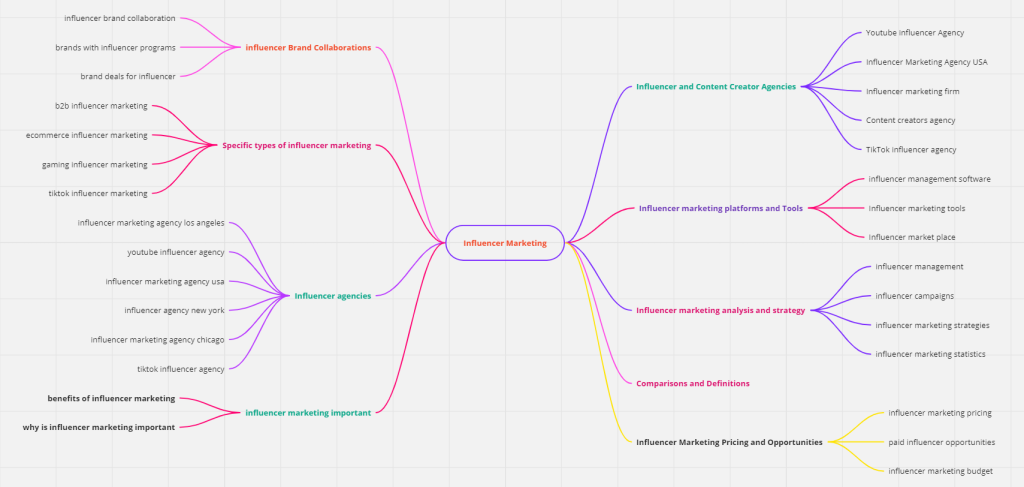
– Why Creating Topical Maps Matter in SEO
Search engines, especially Google, have undergone a significant transformation in their ability to comprehend text contextually, moving beyond the simple matching of exact keywords.
Google, in particular, has committed itself to delivering results centered on user intent, leveraging advanced algorithms such as Hummingbird and Rank Brain.
One prime example of this evolution is Google’s Knowledge Graph, which excels at identifying connections between various online entities, be they people, places, or ideas.
Recent helpful content update algorithms have further solidified Google’s dedication to prioritizing search queries from websites that offer the most value to readers.
On a parallel note, Semantic SEO Writing transcends merely understanding the intent behind a query; it involves a deeper exploration to accurately identify interconnected concepts within specific topics.
When done correctly, it ultimately helps in making your website’s content more helpful to its viewers, boosting your visibility in the long term.
With that in mind, there are several ways creating Topical maps can help you improve the semantic relevance of your content:
- Improved Content Relevance: By mapping out the topics within a specific subject area, you can create content that covers all aspects of the subject, making it more relevant to your audience.
- Enhanced Keyword Optimization: SEO Topical maps can help you identify and optimize for a wider range of keywords, including long-tail keywords that can improve your content’s visibility on search engines.
- Better Content Interlinking: With a topical map, you can create a network of interlinked content pieces that enhance the user experience and improve your site’s SEO.
How to Create a Topical Map
Even so, building topical authority isn’t about churning out 100 articles daily and anticipating immediate results.
Instead, it centers on producing semantically relevant content that delves deeply into each topic within your niche/industry.
Therefore, always prioritize the reader’s intent and aim for comprehensive coverage.
Above all, emphasize the creation of topic clusters, with a particular focus on informational posts.
Understanding Topic and Sub-Topic Hierarchy
In order to construct a well-structured content network, it’s crucial to grasp how Google organizes your topic into a topic/subtopic hierarchy.
Why?
Google likely already includes your primary entity within its Knowledge Graph, and this graph incorporates a topic layer structured as topic/subtopic.
Since you’re creating a structure to assist both users and Google in understanding your website’s essence, aligning it with Google’s perception of the topic is beneficial.
The Google Search Engine Results Pages (SERPs) are your compass for this.
Begin by generating lists of related entities and queries. You can do this by observing SERP features like;
- Knowledge Panels,
- People Also Ask boxes, and
- Google Auto-Complete.
We’ll explore each of these in more detail below.
1. Niche SEED Keyword
As you start to create a topical Map for SEO, selecting the right SEED keyword is paramount because it serves as the cornerstone of your entire keyword research effort.
Make sure to refer to our previous post, where we discussed in detail how to identify and generate topical keywords.
The seed keyword sets the central theme for your topical map, around which all other related topics and subtopics orbit.
Think of it as the primary term that encapsulates the very essence of your niche.
However, it’s essential for this SEED keyword not to be overly broad.

Instead, it should be specific enough to precisely define your niche while allowing you to branch out into multiple related topics.
2. Keyword Research
Keyword research is the backbone of any SEO strategy, and when creating a Topical Map, it’s no different.
Coupled with entity identification, this step ensures your topical map is both comprehensive and semantically relevant.
Steps for Effective Keyword Research when preparing a Topical Map:

– Start with the SEED Keyword: Use your previously identified SEED keyword as the foundation for your research.
– Expand with SEO Tools: Utilize trusted SEO tools to uncover related keywords, synonyms, and long-tail variations. Tools like SEMrush & Ahrefs can be invaluable here.
– Entity Identification in Topical Mapping: They can be anything from places, people, brands, or even abstract ideas. Identifying these entities ensures your content aligns with the semantic understanding of search engines.
To effectively Identify Entities, review your keyword research results and look for nouns that can be classified as entities.
Building on Your Keyword Research Results
As mentioned earlier, preparing a topical map involves thorough research.
This means one of your objectives is to uncover queries that Google associates with it.
Therefore, keep an eye out for “People Also Ask” boxes in the search results after you search your seed keyword.

These queries can often be naturally grouped into subtopics and related ideas, which will be helpful later on.
Next, consider Knowledge Panels – those informative boxes you see on Google when searching for entities like people, places, organizations, or things from the Knowledge Graph.
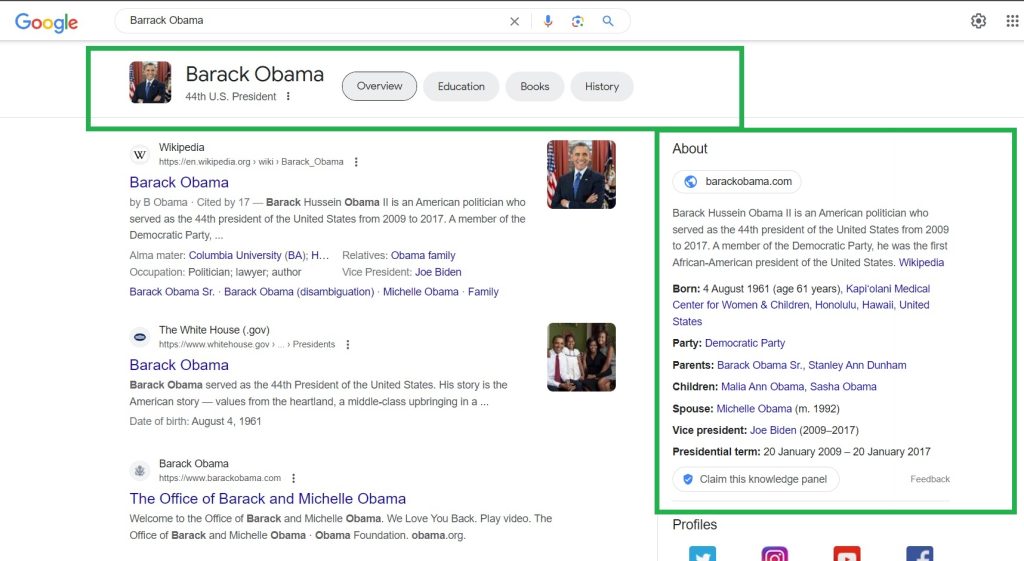
These panels provide quick, condensed information about a topic, drawing from Google’s interpretation of available web content.
As such, they can be valuable sources of insights as you navigate the terrain of your chosen topic for your topical map.
Lastly, Google Autocomplete is another powerful tool for discovering subtopics and related ideas.
As you type your primary keyword into the Google search bar, Autocomplete suggests search queries that are frequently used by other users.

These suggestions are often phrased as questions or keywords related to your topic.
By exploring these autocomplete suggestions, you can quickly identify subtopics and related ideas that are relevant to your SEED keyword, making it an invaluable resource for expanding your topical map efficiently.
3. Keyword Clustering
Once you’ve amassed a list of keywords and identified relevant entities, the next step is to organize this information.
To gain a deeper insight, make sure to refer to our previous detailed post about keyword and topic clustering.
Clustering, in this context, means grouping keywords and entities based on their semantic relevance to form coherent topic clusters.
This is important for two reasons;
- Logical Content Flow: Clustering both topics and keywords ensures that your content follows a logical and organized flow, making it easier for both users and search engines to navigate and understand.
- Enhanced Content Relevance: Grouping related keywords and entities together ensures that each piece of content you create is comprehensive and thoroughly addresses a specific topic or subtopic.
To effectively achieve this, consider;
— Using Dedicated Keyword Tools: Tools like Keyword-Cupid and SEMRUSH automate the clustering process, grouping keywords based on their semantic relationships.
— Manual Review: While tools are helpful, a manual review ensures that the clusters make sense contextually. Adjust and refine clusters based on your niche expertise.
4. Topic Visualization When Creating a Topical Map
Once you have your keyword clusters, the next step is to identify main topic themes and transition these groups of keywords into a more interconnected topic-themed model.
This step is important as it helps you better understand the topic/subtopic hierarchy, which will be valuable in planning semantically relevant content.
Here’s how to do it:
1. Understand Cluster Themes:
- Review each cluster and identify the overarching theme or concept represented by the keywords within it.
2. Establish Parent Topics:
- Choose keywords or phrases that are most relevant to the overall meaning and context of the cluster. These should be terms that succinctly convey the primary focus of that particular group of keywords and will also serve as parent topics.
3. Identify Sub-Topics
- For each cluster, identify keywords that are broad enough to be subtopics under the corresponding parent topic (theme) of that group. Remember, each subtopic will have a set of one or more keyword clusters with semantically relevant search phrases.
4. Using Mind-mapping tools to Visualize Topics
- With a clear understanding of the parent-child hierarchy, proceed to use mind-mapping tools to visualize the primary themes and show how the detailed sub-topics fit and branch out. Remember, when done correctly, it should make the next step – preparing topic clusters, effortless.

This visual structure ensures that while you have in-depth content on specific items, there’s also a broader perspective available to help you when planning your website’s content.
5. Planning a Topic Cluster Content Strategy:
The next step is to transition to a topic-clustering approach.
This strategy ensures that your content is organized and interconnected, providing comprehensive coverage of each topic.
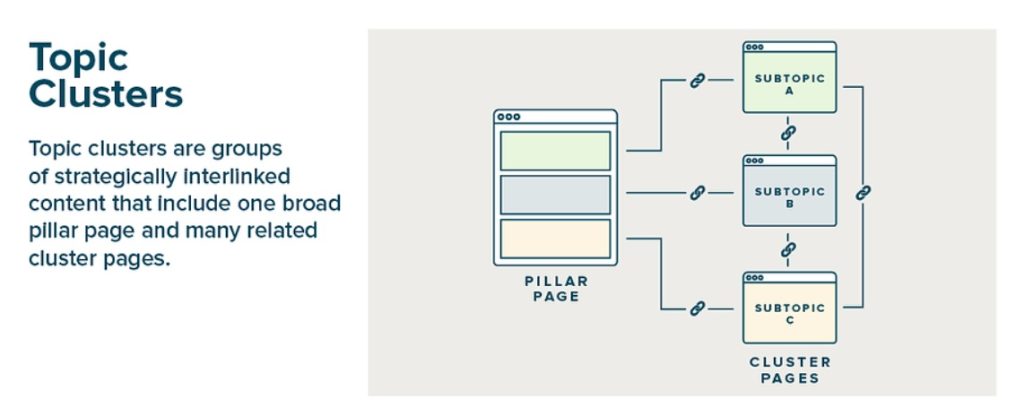
a. Pillar Content Planning:
Pillar content serves as the foundation of each topic cluster. It provides a broad overview of a topic, linking out to more specific cluster content pieces within the associated subtopics.

For instance, the “Men’s Shoes” (category) could serve as the pillar content, discussing general trends and types of shoes for men.
Underlying sub-topics (sub-categories) like “Men’s Running Shoes”, “Men’s Formal Shoes”, and “Men’s indoor shoes” become cluster content, providing more in-depth details about each section.
b. Detailed Cluster Content:
As discussed in the previous section, detailed pillar pages like “Men’s Shoes” would have in-depth content focusing on specific aspects, brands, and types.
Consequently, the cluster content serves as the supporting pages, discussing in detail the sections that were mentioned on the pillar page.

c. ) Interlinking
Each piece of cluster content should link back to its associated pillar content. Additionally, where relevant, interlink between cluster content pieces to provide users with a seamless flow of information.
This not only enhances user navigation but also strengthens the SEO value of the interconnected pages.
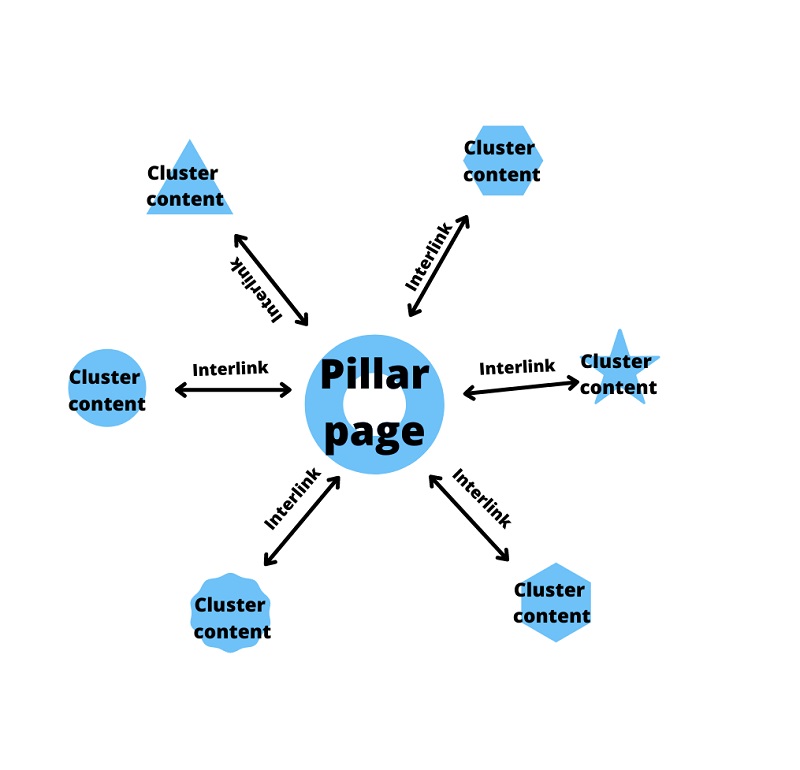
6. Competitor Analysis
In the journey to building an effective SEO Topical Map, understanding your competition is just as invaluable.
This is important for several reasons;
Content Gap Identification: By analyzing competitors, you can discover topics they’ve covered that you might have missed. This ensures your topical map is as comprehensive as possible.
Keyword Insights: Reviewing competitors can reveal additional keywords or phrases that are driving traffic to their sites. Incorporating these into your topical map can further enhance its effectiveness.
Structural Inspiration: Observing how competitors organize their content can offer ideas on how to structure your own topical map for clarity and user-friendliness.
To effectively achieve this, start by listing websites or businesses that rank well for your SEED keyword and related terms.
— Analyze Their Content: Dive into the content of these competitors. What topics do they cover extensively? Are there areas you’ve overlooked?
— Evaluate their Content Structure: Look at how competitors have organized their content. Are they using pillar pages? How do they interlink related subtopics?
7. Content Depth and Format Consideration:
The next step is to determine the depth and format of the content for each topic cluster.
This ensures that your content not only provides value but also caters to diverse user preferences and search intents.
Assessing User Intent:
Before deciding on content depth, it’s crucial to understand the user intent behind each topic cluster.
For instance, someone searching for “Men’s Running Shoes” might be looking for buying guides, reviews, or general information about running shoe types.
Choosing the Right Format:
Different topics and user intents might require different content formats. Here are some considerations:
Long-form Articles: Ideal for in-depth guides, reviews, and comprehensive overviews. For instance, a complete guide on “Choosing the Right Men’s Running Shoes” would benefit from a long-form article format.
Standard Length: Common for average blog posts pieces that support long-form articles, and provide a moderate level of detail.
Videos: Great for tutorials, reviews, or showcasing products.
Interactive Content: Quizzes, calculators, or interactive charts can enhance user engagement.
Content Calendar:
As you create a topical map, you can streamline the content planning process by developing a content calendar. This helps in ensuring regular content updates and allows for strategic content rollout.
While it’s essential to stick to the calendar, it’s equally important to remain flexible to accommodate any industry updates, trends, or emerging topics.
8. Enhance Content Relevance With LSI Phrases
To ensure that your content resonates with both users and search engines, it’s imperative to enhance its contextual relevance.
This involves incorporating relevant LSI phrases and ensuring that the content aligns with the user’s search intent.
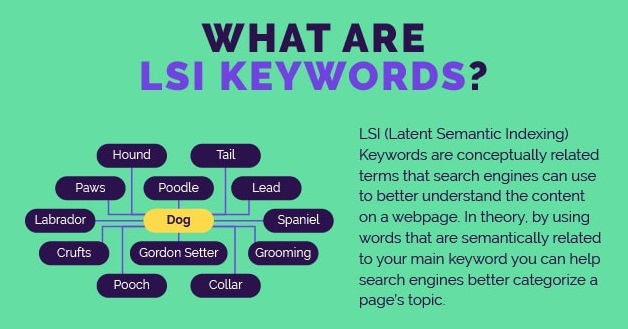
LSI (Latent Semantic Indexing) phrases are terms and phrases related to your main keyword. They provide context and help search engines understand the topic of your content better.
For a detailed article about “Men’s Running Shoes,” LSI phrases might include “cushioning,” “arch support,” “running shoe brands,” and “best running shoes for flat feet.”
You can utilize tools like ChatGPT or other keyword research tools to discover relevant LSI phrases for each target keyword.
9. Translating Your Topical Map Into Site Architecture
Now that you’ve crafted a robust topical map complete with topics and subtopics, as well as a comprehensive list of queries for each of them, it’s time to translate your website structure based on this map.
There are several ways to do this to guide both users and search engine crawlers.
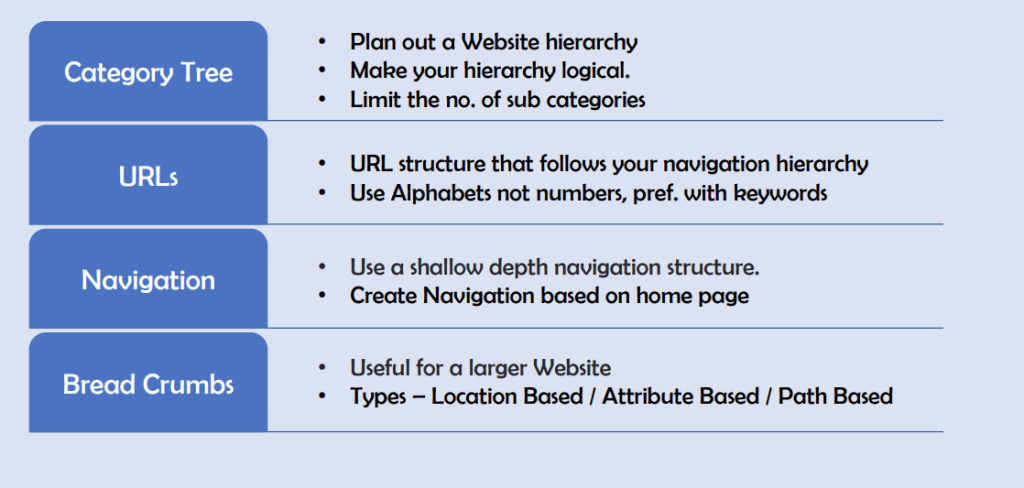
Here are some options to consider:
Internal Links:
As we saw earlier, Internal linking is critical for a successful topic cluster strategy.
By strategically linking related content within your website, you create a logical and hierarchical structure that helps both users and search engines navigate your site’s content effectively.
Breadcrumbs:
Implementing breadcrumbs offers users a clear path to follow within your website. It enhances the user experience, making it easier for them to understand the site’s organization and find their way back if needed.
URL Structure:
A well-thought-out URL structure that aligns with your topical map can further clarify your website’s hierarchy. It provides a visual cue to both users and search engines about the content’s place within the site.
Structured Data:
Structured data, often implemented using schema markup, provides search engines with additional information about the content on your page. Creating a topical map with appropriate schema markup guidelines can lead to rich results in search engines.
There are numerous schema types to consider, including those tailored for articles, services, product reviews, events, and recipes. Make sure to select the schema that aligns most closely with the nature of your content.

FINAL THOUGHTS
Creating a Topical Map in Semantic SEO is a great way to organize content and display the structure of your website.
When used correctly, it can help improve user experience, enhance navigation on the site, and promote good content discovery.
Most importantly, creating a topical map will boost SEO by helping search engines to better understand the content structure of your website.



